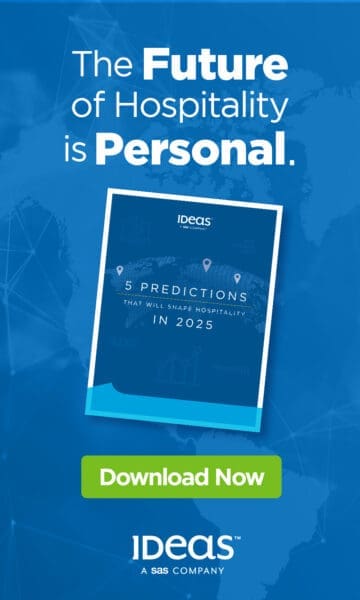 The hotel industry has always been a leader in customer service, but much like other businesses, it risks losing its edge if it doesn’t keep up with changes in technology and consumer behaviour.
The hotel industry has always been a leader in customer service, but much like other businesses, it risks losing its edge if it doesn’t keep up with changes in technology and consumer behaviour.
Hotels are often cited for staff going “above and beyond” to fix a guest’s problem. But as it stands now, so much of the service culture in hotels is reactionary; staff wait for guests to complain and then often have to overcompensate to make up for the error.
Couple this with today’s easy access to technology and review sites, short attention spans and expectations of on-the-spot resolution, and you have hotels scrambling to fix any service error before it harms their online reputation.
Reactive guest service has become standard in the industry. Back in 2009, TripAdvisor reported that 4% of negative reviews received a management response. In 2018, hotels responded to 37.5% of negative reviews from all review sources, according to a global study from ReviewPro.
Clearly, the hotel industry recognizes that responding to reviews is an effective way to appease disappointed guests and win over new guests. But all this responding is a lot of work. What if hotels spent more time preventing issues in the first place?
Proactive feedback
One popular way to prevent service lapses from becoming bad online reviews is by employing post-stay surveys. Rather than wait to learn about a guest’s stay on a review site, hotels actively seek out the opinion of guests. Because surveys are delivered through a private email channel, they provide an opportunity for the hotel to fix issues before they go public in the form of a review.
But that’s only the beginning. In contrast to online reviews, where the review site decides which questions to ask, guest surveys can be customized to serve the hotel’s needs. If the guest identifies a problem in a survey response, it can trigger follow-up questions asking for more detailed feedback.
Rather than sending the same generic survey to all guests, hotels can and should send customized surveys to key segments such as corporate guests, meeting attendees and loyalty members, all of whom have different needs and expectations.
Surveys can also be enriched with PMS data to segment survey results by a range of variables such as room number, guest nationality, and loyalty membership status. This allows hotels to understand the needs of different types of guests and act accordingly.
By combining survey data with online review data hotels acquire a 360-degree view of guest satisfaction, can quickly see which factors affect the bottom line, and can act accordingly. Only with such detailed and precise feedback can hotels systemically prevent issues from occurring.
Temperature checks
As valuable as post-stay surveys are, they are still sent to guests after their stay, when it may be too late to fix things for that particular guest. To gain a more proactive and holistic approach hotels should combine post-stay surveys with on-property ‘temperature checks’.
The simplest form of temperature check is for staff to ask guests, “How is everything going with your stay?” and “What can we do to make your stay even better?” Such open-ended questions bring up issues that guests may not otherwise volunteer but can turn up in a review.
The problem is this system depends on the initiative of staff, and some may avoid the question for fear of prompting a complaint. Moreover, as employee-guest interactions shift to digital channels, face-to-face encounters are diminishing.
To be consistent and effective, temperature checks must be automated. The most efficient delivery mechanism is a brief in-stay survey. Shortly after arrival or during mid-stay, guests receive a text or email asking them to rate their stay so far. Any issues are flagged for immediate resolution.
How effective are in-stay surveys? In a recent global study of 177 hotels, ReviewPro found that hotel guests who reported a problem by in-stay survey was fixed while the guest was still on property gave 12.25% higher ratings in the post-stay survey than guests who reported a problem that went unfixed.
People understand that mistakes happen. The true test is how well—and, increasingly, how quickly—mistakes are resolved.
Guest messaging
Another factor driving people’s expectations of immediacy is the explosive popularity of messaging. People keep smartphones at their sides 24/7, and a growing amount of daily communications among friends and family now happens via text messaging and messaging apps like Facebook Messenger and WhatsApp. Where guests once reached for the in-room handset, they now reach for their smartphones.
While the thought of offering messaging may make some hoteliers worry about how to staff yet another method of communication, when managed properly—using a messaging platform integrated with a case management solution—messaging creates efficiencies, saves time and frees staff up to provide more personalized service.
Communication can even begin before the guest arrives in the form of a web chat service—or at any point in the traveler journey, with rapid responses to their needs.
Whether via guest surveys or messaging, in-stay communications represent a form of preventative maintenance. Much like housekeeping and engineering staff perform routine maintenance and deep cleaning of guest rooms and public spaces to fix things before they get broken, hotel managers perform temperature checks with guests to identify and resolve potential issues on the spot.
Proactive + reactive
In 2019, the hotel industry must look toward combining proactive and reactive guest service, an approach that is holistic, timely, and current. This requires adopting the latest communication tools and putting the staff and processes in place to ensure quick responses and follow-up. Only then can the industry continue to champion its position as a leader in customer service.



















